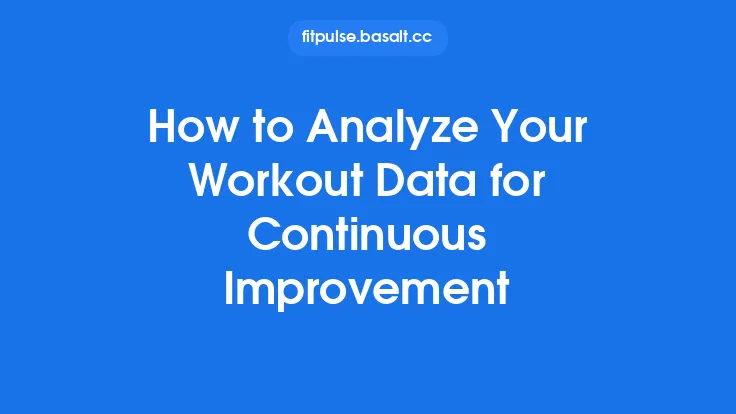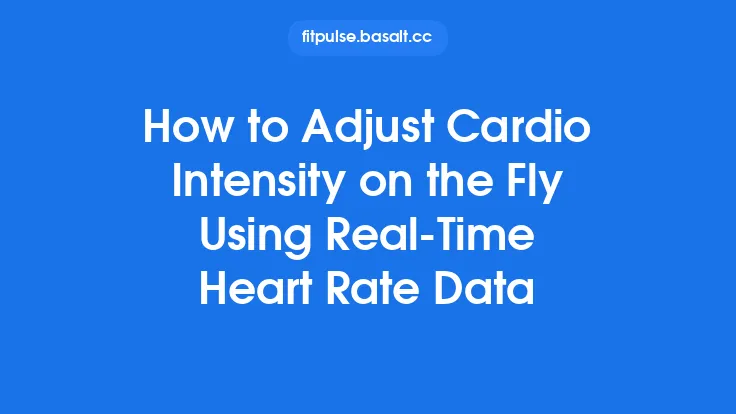The modern fitness enthusiast is surrounded by a constant stream of numbers: heart‑rate spikes, cadence curves, power‑output graphs, sleep stages, and even stress‑level readings from smart rings. While each data point tells a fragment of a story, the real value emerges when these fragments are woven together into a coherent narrative that can guide the next workout, recovery strategy, or long‑term goal. AI‑driven coaching platforms have become the architects of this narrative, turning historical performance records into actionable future plans. This transformation hinges on a sophisticated pipeline that moves from data ingestion to insight extraction, predictive modeling, and finally to personalized prescription—all while maintaining a feedback loop that refines the system over time.
Understanding the Data Landscape
1. Multimodal Data Sources
Fitness data no longer lives solely on a treadmill console. Contemporary platforms ingest information from:
- Wearable sensors – accelerometers, gyroscopes, optical heart‑rate monitors, skin temperature, galvanic skin response.
- Environmental inputs – altitude, temperature, humidity, air quality, which affect exertion and recovery.
- User‑generated content – manual logs of perceived exertion (RPE), mood, nutrition, injury reports.
- Device‑level telemetry – power meters, smart bike cadence, rowing stroke force, weight‑lifting velocity.
Each source contributes a different “modality” that must be synchronized in time and normalized to a common reference frame. For instance, a heart‑rate curve sampled at 1 Hz must be aligned with a power curve sampled at 10 Hz, often using interpolation or resampling techniques.
2. Data Quality and Pre‑processing
Raw sensor streams are noisy. Common issues include:
- Signal dropout – loss of Bluetooth connection or sensor displacement.
- Motion artefacts – especially in optical heart‑rate sensors during high‑intensity intervals.
- Calibration drift – power meters can lose accuracy over time.
AI pipelines typically employ a combination of statistical filters (e.g., Kalman filters for smoothing) and machine‑learning‑based anomaly detectors (e.g., autoencoders trained on “normal” workout patterns) to clean the data before any higher‑level analysis.
3. Feature Engineering for Fitness
Beyond the obvious metrics (average heart‑rate, total distance), richer features are derived:
- Time‑domain features – peak power, time‑to‑peak, recovery slope.
- Frequency‑domain features – spectral entropy of heart‑rate variability, indicating autonomic balance.
- Event‑based features – number of “splits” where power exceeds a threshold for a given duration.
- Contextual tags – “outdoor run”, “strength circuit”, “post‑injury”.
These engineered features become the language that predictive models understand.
From Raw Metrics to Meaningful Insights
1. Pattern Recognition with Unsupervised Learning
Clustering algorithms (e.g., DBSCAN, hierarchical clustering) can group workouts that share similar physiological signatures. This reveals hidden patterns such as “high‑intensity interval days” versus “steady‑state endurance days” without explicit labeling.
2. Dimensionality Reduction for Visualization
Techniques like t‑SNE or UMAP project high‑dimensional feature spaces into 2‑D maps that users can explore. A user might see a “cloud” of recent workouts shifting toward a new region, indicating a change in training focus (e.g., moving from cardio‑dominant to strength‑dominant sessions).
3. Deriving Baseline Profiles
By aggregating data over a rolling window (e.g., the past 4 weeks), the system constructs a baseline profile for each metric:
- Cardiovascular baseline – resting HR, HRV, VO₂max estimate.
- Strength baseline – average peak power, velocity‑based load metrics.
- Recovery baseline – average sleep efficiency, post‑exercise HRV rebound.
These baselines serve as reference points for detecting deviations that may warrant plan adjustments.
Predictive Modeling: Forecasting Future Performance
1. Time‑Series Forecasting
Recurrent neural networks (RNNs), especially Long Short‑Term Memory (LSTM) cells, excel at modeling sequential data. An LSTM can be trained to predict next‑week power output given the past 30 days of training, sleep, and stress data. The model outputs a probability distribution rather than a single point estimate, allowing the system to express confidence intervals.
2. Gradient‑Boosted Decision Trees for Structured Data
Algorithms like XGBoost or LightGBM handle tabular features efficiently. They can predict outcomes such as “probability of achieving a 5 km personal best” based on current training load, recovery metrics, and historical progression trends.
3. Hybrid Models
Combining deep learning for temporal patterns with gradient‑boosted trees for static contextual variables (e.g., age, injury history) yields a more robust predictor. The hybrid architecture often uses the deep model to generate embeddings that feed into the tree‑based model.
4. Counterfactual Simulations
Once a predictive model is trained, it can be queried with “what‑if” scenarios. For example, “If I add two 30‑minute tempo runs next week, how will my predicted 10 km time change?” The system runs the model forward with the altered input, providing a data‑driven estimate of the impact.
Personalized Plan Generation
1. Objective Function Design
At the heart of plan generation lies an optimization problem. The objective function balances multiple goals:
- Performance improvement – maximize predicted gain in target metric (e.g., power, speed).
- Recovery preservation – minimize predicted risk of overreaching, often modeled as a penalty on cumulative training stress.
- User preferences – incorporate constraints like “no more than three high‑intensity sessions per week” or “prefer morning workouts”.
Mathematically, the problem can be expressed as:
max Σ w_i * ΔMetric_i – λ * Σ Risk_j
subject to Constraints (time, equipment, user preferences)
where `wi` are weights for each performance metric, `ΔMetrici` are predicted improvements, and `λ` controls the trade‑off with risk.
2. Solver Techniques
Depending on the complexity, different solvers are employed:
- Linear programming for simple, convex formulations.
- Mixed‑integer programming when decisions are binary (e.g., “include a hill repeat or not”).
- Evolutionary algorithms for highly non‑linear, multi‑objective problems, allowing the system to explore a diverse set of viable plans.
3. Adaptive Prescription
The generated plan is not static. Each day’s actual performance feeds back into the model, updating the risk estimates and adjusting upcoming sessions. This “rolling horizon” approach mirrors model predictive control (MPC) used in engineering, where the plan is continuously re‑optimized as new data arrives.
4. Explainability for Users
To foster trust, the system translates the optimization output into human‑readable rationales:
- “Your recent HRV suggests you are well‑recovered; adding a 20‑minute tempo run will likely improve your 5 km time by ~3%.”
- “Your cumulative training load is approaching the 85% threshold; we recommend a recovery swim tomorrow.”
These explanations are generated using rule‑based templates combined with the model’s quantitative outputs.
Closing the Loop: Real‑Time Adaptation and Feedback
1. Continuous Monitoring
During a workout, streaming data (e.g., heart‑rate, power) is compared against the predicted trajectory for that session. Deviations trigger micro‑adjustments:
- Pacing cues – if power is lagging behind the target zone, a gentle audio prompt suggests increasing cadence.
- Early termination – if heart‑rate exceeds a safety threshold, the system recommends ending the interval.
2. Post‑Workout Analysis
After each session, the platform computes a “performance delta” – the difference between planned and actual metrics. This delta updates the user’s baseline profile and informs the next optimization cycle.
3. Long‑Term Learning
Aggregated deltas across weeks feed into a meta‑learning layer that refines the underlying predictive models. Techniques such as online gradient descent or Bayesian updating allow the system to adapt to long‑term physiological changes (e.g., aging, training plateaus).
Ensuring Reliability and Trustworthiness
1. Model Validation
Before deployment, models undergo rigorous validation:
- Cross‑validation across users to ensure generalizability.
- Hold‑out testing on unseen weeks to assess forecasting accuracy.
- Calibration checks to verify that predicted probabilities align with observed outcomes (e.g., using reliability diagrams).
2. Guardrails Against Over‑Prescription
Safety constraints are hard‑coded into the optimizer:
- Maximum weekly training stress score (TSS) caps.
- Minimum rest days enforced regardless of predicted gains.
- Injury‑risk flags based on historical pain reports.
3. Transparency Audits
Periodic audits compare the AI’s recommendations with expert trainer decisions. Discrepancies are logged, and the system is retrained if systematic biases emerge (e.g., consistently over‑estimating gains for a specific demographic).
Practical Implementation: From Cloud to Wrist
1. Edge vs. Cloud Processing
Heavy‑weight model training and batch analytics run on cloud servers with GPU acceleration. Real‑time inference (e.g., pacing cues) is pushed to the edge—either on the wearable’s microcontroller or a paired smartphone—to reduce latency and preserve connectivity independence.
2. Data Pipeline Architecture
[Sensor Stream] → [Edge Pre‑processor] → [Secure MQTT/HTTPS] → [Cloud Ingestion Layer]
↓ ↓
[Local Feature Extraction] [Data Lake (Parquet/Delta)]
↓ ↓
[Realtime Inference Service] [Batch ML Training (Spark/Databricks)]
↓ ↓
[User Feedback UI] [Model Registry & CI/CD]
- Security – end‑to‑end encryption, token‑based authentication, and strict data‑retention policies.
- Scalability – serverless functions handle spikes (e.g., during a global challenge event).
3. Integration with Existing Platforms
APIs conform to industry standards such as the Open mHealth schema, enabling seamless data exchange with third‑party nutrition trackers, sleep monitors, or electronic health records (EHRs) for a holistic view of the user’s wellness.
Future Directions and Emerging Capabilities
1. Multimodal Fusion with Vision
Computer‑vision models can analyze video of a user’s movement to extract biomechanical cues (e.g., stride symmetry) that complement sensor data, enriching the performance history used for planning.
2. Federated Learning for Privacy‑Preserving Personalization
Instead of uploading raw data, devices locally train model updates that are aggregated on the server. This approach maintains user privacy while still benefiting from collective learning across millions of athletes.
3. Adaptive Goal Setting via Reinforcement Learning
A reinforcement‑learning agent can treat the user’s long‑term fitness objective as a reward signal, learning policies that balance short‑term strain with progressive goal attainment. Early prototypes show promise in automatically adjusting target race times as the athlete’s capacity evolves.
4. Integration of Psychophysiological Signals
Emerging wearables capture cortisol levels, pupil dilation, or EEG‑derived focus metrics. Incorporating these signals could allow AI coaches to schedule mentally demanding sessions when the user’s cognitive readiness is high, further personalizing the plan.
By systematically converting historical performance data into predictive insights, optimizing personalized training prescriptions, and continuously closing the feedback loop, AI‑driven coaching platforms turn raw numbers into purposeful action. The result is a dynamic, data‑backed roadmap that evolves with the athlete, helping them progress safely, efficiently, and with a clear understanding of why each recommendation matters.




